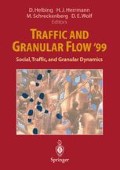Abstract
We discuss simulations of flocking and the principle of optimal self-organisation during self-driven motion of many similar objects. In addition to driving and interaction the role of fluctuations is taken into account as well. In our models, the particles corresponding to organisms locally interact with their neighbours by choosing at each time step a velocity depending on the directions of motion of them. Our numerical studies of flocking indicate the existence of new types of transitions. As a function of the control parameters both disordered and long-range ordered phases can be observed, and the corresponding phase space domains are separated by singular “critical lines”. In particular, we demonstrate both numerically and analytically that there is a disordered-to-ordered-motion transition at a finite noise level even in one dimension. We also present computational and analytical results indicating that driven systems with repulsive interactions tend to reach an optimal state corresponding to minimal interaction. This extremal principle is expected to be relevant for a class of biological and social systems involving driven interacting entities.
Access this chapter
Tax calculation will be finalised at checkout
Purchases are for personal use only
Preview
Unable to display preview. Download preview PDF.
References
J.K. Parrish and L. Edelstein-Keshlet, Science 284, 99 (1999).
C.W. Reynolds, Computer Graphics 21, 25 (1987).
E.M. Rauch, M.M. Millonas, and D.R. Chialvo, Phys. Lett. A 207, 185 (1995).
T. Vicsek, A. Czirok, E. Ben-Jacob, I. Cohen, and O. Shochet, Phys. Rev. Lett. 75, 1226 (1995).
R.B. Stinchcombe, In:Phase Transitions and Critical Phenomena, C. Domb and J. Lebowitz, (Eds.), Vol. 7, (Academic Press, New York, 1983).
A. Czirók, A.-L. Barabási, and T. Vicsek, Phys. Rev. Lett. 82, 209 (1999).
J. Toner and Y. Tu, Phys. Rev. Lett. 75, 4326 (1995).
A. Czirók, H.E. Stanley, and T. Vicsek, J. Phys. A 30, 1375 (1997).
A. Czirók, E. Ben-Jacob, I. Cohen, and T. Vicsek, Phys. Rev. E 54, 1791 (1996).
Y.L. Duparcmeur, H.J. Herrmann, and J.P. Troadec, J. Phys. I France 5, 1119 (1995).
J.Hemmingsson, J. Phys. A 28, 4245 (1995).
A. Czirók, M. Vicsek, and T. Vicsek, Physica A 264, 299 (1999).
J. Kertész, D. Stauffer, and A. Coniglio, In:Percolation Structures and Processes, G.D. Deutcher, R. Zallen, and J. Adler, (Eds.), p. 121 (Adam Hilger, 1983).
D. Helbing, and T. Vicsek, New J. of Physics 1, No. 13, (1999); (see http: //www. n jp. org/).
J. Keizer, Statistical Thermodynamics of Nonequilibrium Processes, (Springer, New York, 1987).
H. Haken, Information and Self-Organization,(Springer, Berlin, 1988).
G. Nicolis and I. Prigogine, Self-Organization in Nonequilibrium Systems. From Dissipative Structures to Order through Fluctuations, (Wiley, New York, 1977).
T. Vicsek, Fractal Growth Phenomena, (World Scientific, Singapore, 1992).
D. Helbing, Quantitative Sociodynamics, (Kluwer, Dordrecht, 1995).
D. Helbing, J. Keltsch, and P. Molnár, Nature 388, 47 (1997).
D. Helbing and P. Molnár, Phys. Rev. E 51, 4282 (1995).
S.B. Santra, S. Schwarzer, and H. Herrmann, Phys. Rev. E 54, 5066 (1996).
D. Helbing and B.A. Huberman, Nature 396, 738 (1998).
D. Helbing, Verkehrsdynamik, (Springer, Berlin, 1997).
R. Graham and T. Tél, In: Stochastic Processes and Their Applications, S. Albeverio, P. Blanchard, and L. Streit (Eds.), p. 153 (Kluwer, Dordrecht, 1990).
Author information
Authors and Affiliations
Editor information
Editors and Affiliations
Rights and permissions
Copyright information
© 2000 Springer-Verlag Berlin Heidelberg
About this paper
Cite this paper
Vicsek, T., Czirok, A., Helbing, D. (2000). Collective Motion and Optimal Self-Organisation in Self-Driven Systems. In: Helbing, D., Herrmann, H.J., Schreckenberg, M., Wolf, D.E. (eds) Traffic and Granular Flow ’99. Springer, Berlin, Heidelberg. https://doi.org/10.1007/978-3-642-59751-0_14
Download citation
DOI: https://doi.org/10.1007/978-3-642-59751-0_14
Publisher Name: Springer, Berlin, Heidelberg
Print ISBN: 978-3-642-64109-1
Online ISBN: 978-3-642-59751-0
eBook Packages: Springer Book Archive

